文章信息
- 于焕云, 崔江虎, 乔江涛, 刘传平, 李芳柏
- YU Huan-yun, CUI Jiang-hu, QIAO Jiang-tao, LIU Chuan-ping, LI Fang-bai
- 稻田镉砷污染阻控原理与技术应用
- Principle and technique of arsenic and cadmium pollution control in paddy field
- 农业环境科学学报, 2018, 37(7): 1418-1426
- Journal of Agro-Environment Science, 2018, 37(7): 1418-1426
- http://dx.doi.org/10.11654/jaes.2018-0730
文章历史
- 收稿日期: 2018-05-02
- 录用日期: 2018-06-07
根据2014年原环境保护部与原国土资源部联合发布的全国土壤污染公报显示,耕地土壤点位超标率为19.4%,其中轻中度污染占超标点位的94.3%[1]。耕地土壤重金属污染带来了较为严重的农产品重金属污染风险[2]。农产品中主要超标元素为重金属镉与类金属砷。所有粮食作物中,稻米的镉与砷超标率最高[3]。稻田镉/砷污染治理是我国农田重金属污染治理的重点与难点。
然而,大面积稻田重金属污染治理技术难度大,国内外都缺乏成熟的技术。场地修复等工程技术虽实现了土壤污染物达标的治理功能,但需要中断农业生产,难以解决大面积的稻田重金属污染治理需求。我国水稻主产区的重金属污染复杂性世所罕见,土壤与稻米中重金属含量并不存在一一对应关系,降低土壤重金属含量至达标水平并不能确保稻米安全达标。因此,必须突破国外既有理论和技术模式,研发农民可接受、政府可承受、产业可发展、易于大面积推广的技术。
基于生物地球化学理论,稻田重金属行为是水-土-气-生共同作用的地表过程。镉/砷等元素从土壤矿物至植物根表的迁移机制、从根至籽粒的转运机制,是关键科学问题。从基础入手,研发降低重金属从矿物迁移至根表的钝化技术、阻控可食部位积累重金属的生理阻隔技术,是阻控稻米镉/砷积累的有效途径。本文将重点介绍稻田镉/砷污染阻控的技术原理与应用效果。
1 阻控技术原理 1.1 生理阻隔技术原理镉、砷是水稻生长非必需元素,可借助铁、锌、锰、磷、硅等必需元素的转运通道进入水稻根部,并向上输送至籽粒中。涉及四个主要过程:根部吸收、木质部转运、跨维管束运输及韧皮部向籽粒迁移。目前已鉴定到多个转运蛋白参与控制水稻镉/砷的吸收转运及籽粒积累。
镉相关转运蛋白。水稻吸收镉的过程中,定位于根部皮层细胞外侧质膜上的OsNramp5转运蛋白在转运锰的同时可高效转运镉,缺铁诱导的OsNramp1、OsIRT1和OsIRT2转运蛋白在促进铁吸收的同时也增强镉的吸收,锌转运蛋白OsZIP1和OsZIP3也可转运镉[4-5]。水稻籽粒镉积累的关键过程是木质部向地上转运及韧皮部向籽粒输送。定位于根部和节内维管束细胞质膜上的OsHMA2是目前发现的木质部装载重要转运蛋白,在装载锌的同时也装载镉[6];定位于液泡膜上的OsHMA3转运蛋白则可将镉转入液泡中隔离,束缚镉向地上部转运[7];定位于节内维管束周围薄壁细胞的质膜上蛋白OsLCT1是目前水稻中发现的与韧皮部转运镉有关的重要转运蛋白,可促进镉向韧皮部装载[8];另外还发现在韧皮部伴胞中表达的OsLCD转运蛋白也与镉向籽粒输送密切相关。
砷相关转运蛋白。分为砷(Ⅴ)和砷(Ⅲ)两类转运蛋白。氧化条件下,土壤砷主要是五价砷As(Ⅴ),通过磷的转运通道进入水稻细胞内,As(Ⅴ)的吸收主要通过磷酸根转运蛋白OsPT8介导,砷(Ⅴ)进入细胞后可被砷酸盐还原酶OsHAC4、OsHAC1;1和OsHAC1;2还原成As(Ⅲ),从而通过As(Ⅲ)的转运通道进行转运和再分配[9-10]。还原条件下,土壤溶液中砷主要是As(Ⅲ),主要通过硅的转运通道进入水稻各部位,As(Ⅲ)主要通过竞争硅转运蛋白OsLsi1通道进入根系,定位在水稻根系内外皮层细胞的远中柱端,从而将根部细胞外的As(Ⅲ)转入细胞中,由OsLsi2装载到木质部中进而输送到地上部。赵方杰等研究发现,过量表达水通道蛋白OsNIP1;1和OsNIP3;3能降低砷向木质部的装载和在水稻地上部及籽粒砷积累[11]。
生理阻隔技术就是调节与稻米镉/砷积累相关的生理过程,抑制水稻对镉/砷等毒害元素的吸收、转运、积累,提高其解毒能力,从而降低稻米中镉/砷含量。目前报道较多的主要为硅、硒和锌营养调控可有效降低稻米镉/砷的积累[12-15];此外,铁、锰、硫和植物调节剂也具有类似的调节功能[16-20]。其中,硅营养提高农作物对镉/砷抗性方面的研究较多[21-22]。为了提高硅、硒等营养元素的生理阻隔效果,降低实施成本,通常采用叶面喷施。针对硅营养调控,为了避免钠、钾等碱金属离子干扰,采用水热合成与电渗析相结合的方法,去除碱金属离子,制备成粒径较小的纳米硅溶胶,可实现硅营养生理阻隔技术的产品化。我们采用悬浮细胞体系研究发现[23],纳米硅溶胶的粒径尺寸是影响水稻细胞吸收镉的关键因子,硅溶胶粒径越小,硅与镉离子的结合位点越多,对镉离子结合能力越明显,从而其抑制水稻细胞吸收镉的效果越显著。硅/硒降低水稻镉/砷积累的机理为(图 1):硅可降低水稻镉吸收基因OsNramp5和转运基因OsLCT1的表达,并提高镉解毒基因OsHMA3的表达,导致大部分镉束缚在细胞液泡内,通过共沉淀作用将镉固定在细胞壁,从而定向调控水稻对镉的吸收与转运[23]。由于As(Ⅲ)主要通过硅转运通道进入水稻,硅可以竞争性地抑制As(Ⅲ)的吸收,并抑制水稻硅转运蛋白OsLsi1、OsLsi2和OsLsi6的表达,从而降低水稻对砷的吸收与转运[11, 24]。
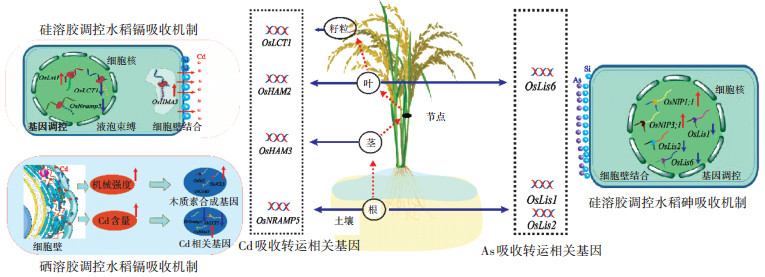
|
| 图 1 硅与硒营养调控水稻砷/镉吸收、转运与解毒机理示意图 Figure 1 The mechanism of silicon and selenium nutrition regulating arsenic/cadmium absorption, transport and detoxification in rice |
硒也具有与硅类似的生理阻隔功能,而且更为重要的是,硒能提高水稻木质素合成基因OsPAL、OsCoMT、Os4CL3的表达,提高水稻细胞的木质素含量、细胞壁厚度和机械强度,有利于镉/砷在细胞壁上的沉积与固定[25-26]。必须注意的是,硒适量有益,过量有毒,且适宜的范围很窄。一般地,硅与硒配合施用比单施效果好。
另外,我国稻田主要分布在热带亚热带地区,高温多雨的气候条件使得土壤强烈风化、淋溶,脱硅富铝化程度高,有效硅含量均较低,缺硅土壤比例高达70%以上[27]。元素地球化学分析结果表明,稻田有效硅含量与水稻植株中镉/砷含量均呈显著负相关[28]。这一区域地球化学特征也决定了水稻硅营养调控是降低水稻镉/砷积累的有效途径。基于此,我们研发了硅溶胶[29]、硒复合硅溶胶[30]、稀土复合硅溶胶[31]等产品,田间应用结果表明,这些产品均可有效缓解镉/砷的毒害效应,并显著降低水稻籽粒中镉/砷积累[22, 32-34]。
1.2 土壤钝化技术原理稻田镉/砷从土壤颗粒表面至水稻根表的迁移过程,是决定其有效性的关键。这一过程与其形态、价态有关,受土壤的酸碱性质、氧化还原状态决定[35-36]。一般地,随着土壤pH值的升高,重金属镉的移动性逐步降低,而类金属砷的移动性逐步升高;随着土壤Eh值的升高,重金属镉的移动性逐步升高,而类金属砷的移动性逐步降低。可见,稻田镉/砷行为受pH-Eh影响表现出完全相反的效果,这是稻田镉/砷钝化技术的难点。
镉是我国稻米超标最为严重的元素[37]。因此,土壤钝化技术大多是围绕钝化镉而研发的。通过向土壤施加碱性物质或者具有较大吸附容量的矿物材料,使土壤中镉与这些材料发生吸附、络合、沉淀、离子交换等一系列物理化学反应,从而降低镉的可溶解性与转移性。早期研发的镉钝化功能材料主要以无机材料为主,包括石灰、碳酸钙等石灰性材料[38],海泡石、沸石、膨润土等粘土矿物[39-41],羟基磷矿粉等磷灰石族矿物[42];后期研发主要为腐植质、生物炭等有机材料[19, 43-45]、微生物菌剂[46-47];以及将无机材料、有机材料、微生物菌剂的两两组合或三者组合的复合材料[48-49]。然而,以提高土壤pH值为切入点的钝化技术,将造成砷活化等次生环境问题。因此,研发稻田镉/砷同步钝化技术是实现钝化技术环境友好的关键。
铁是稻田土壤中最为重要的氧化还原活性元素,在土壤物质循环过程中具有独特的重要性[50]。稻田铁循环是连接碳氮养分循环与镉/砷行为的枢纽,可高效定向调控镉/砷活性、抑制稻米镉/砷积累。具体原理(图 2)为[51-53]:(1)铁还原等微生物作用下,氧化铁被还原为Fe(Ⅱ),同时铁还原过程消耗土壤H+,导致pH升高,促进Cd固定;(2)砷氧化微生物以硝酸盐为电子受体,将As(Ⅲ)氧化为As(Ⅴ),同时硝酸盐还原产物亚硝酸盐化学氧化亚铁为三价铁矿物,促进砷的固定;(3)吸附于氧化铁表面的亚铁,可催化氧化铁晶相转变产生氧化能力较强的新鲜态三价铁,然后化学氧化As(Ⅲ)为As(Ⅴ),从而促进砷的固定;(4)微生物作用下,硝酸盐还原耦合Fe(Ⅱ)氧化生成氧化铁,吸附固定作物可利用态Cd和As(Ⅴ);(5)水稻根际泌氧,与Fe(Ⅱ)发生类Fenton反应,促进根表铁膜形成,进而吸附固定作物可利用态As和Cd。
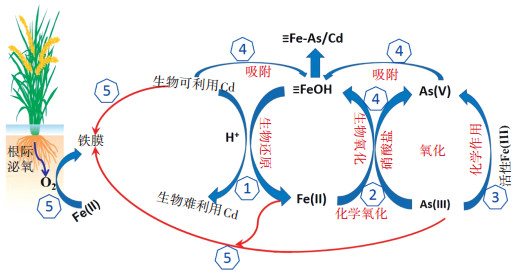
|
| 图 2 稻田铁循环调控砷/镉行为的原理示意图 Figure 2 The principle of iron cycle regulating arsenic/cadmium behaviors in paddy field |
基于以上原理,我们研发了铁基生物质炭材料[54]用于同步钝化土壤中镉/砷,该技术以生物质为原料,通过高温碳化的方法在制备生物质炭的过程中加入含铁化合物,将铁以特定比例掺杂,形成具有特殊结构和功能的铁基生物质炭材料。并在此基础上研发了缓释性铁基生物质炭[55]、铁硅硫多元素复合生物质炭[56]及铁基腐殖质复合材料[57],试验表明这些材料均可实现镉/砷同步钝化[58]。
2 阻控技术应用 2.1 生理阻隔技术应用2013—2016年,我们在广东、湖南、广西三地开展了为期4年的生理阻隔技术应用效果的大田试验。在水稻分蘖盛期及灌浆期以7500 mL·hm-2的用量喷施生理阻隔剂“降镉灵”(含20% SiO2)。成熟期采集水稻样品,采用石墨炉原子吸收测定稻米中镉,高效液相色谱和原子荧光联用测定稻米中无机砷。总体上,生理阻隔技术应用可显著降低稻米中镉/砷的含量(图 3)。相比对照,施用生理阻隔剂后,稻米镉、无机砷含量均值从0.59、0.21 mg·kg-1降至0.32 mg·kg-1和0.15 mg·kg-1,降幅分别为45%和27%;按水稻的种植季节分,施用生理阻隔剂后早稻和晚稻的稻米镉含量与对照相比均显著降低,而稻米砷含量与对照比无显著性差异,但晚稻的稻米砷含量显著低于早稻(图 3)。按稻米镉/无机砷含量≤0.4 mg·kg-1(国家食品卫生标准中稻米镉/砷限值的2倍)为轻度污染,0.4~0.6 mg·kg-1为中度污染,大于0.6 mg·kg-1为重度污染的标准划分,在广东、湖南、广西三地开展的生理阻隔技术应用大田试验样点的稻米镉29%为轻度污染,16%为中度污染,55%为重度污染;稻米砷为轻度污染。施用生理阻隔剂后,轻度、中度及重度污染的稻米镉含量均值分别从0.28、0.49、0.82 mg·kg-1降至0.17、0.30、0.47 mg·kg-1,降幅分别为39%、38%及43%,与对照相比,均呈显著性差异,且轻度污染的稻米镉和无机砷施用生理阻隔剂后均有80%的稻米达到国家食品卫生标准中稻米镉/无机砷限值(0.2 mg·kg-1)(图 3与图 4)。
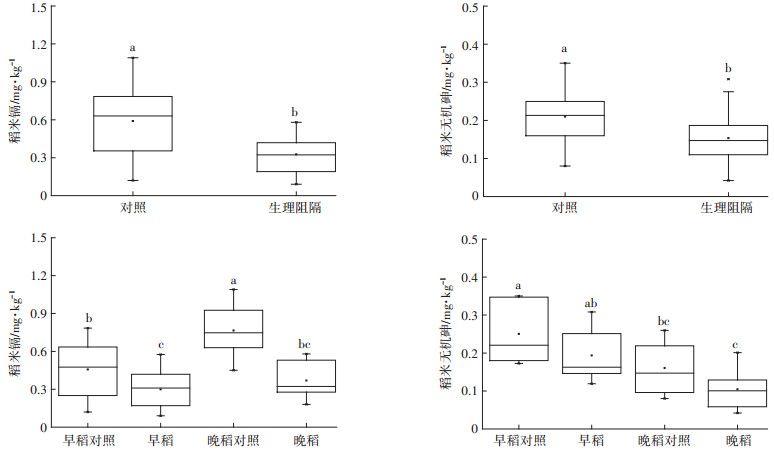
|
| 图中不同小写字母表示处理间差异显著(P<0.05)。下同 图 3 生理阻隔技术在不同季节田间应用降低稻米镉及无机砷的效果 Figure 3 Application of physiological barrier technology to reduce cadmium and inorganic arsenic of rice in paddy fields in different seasons |
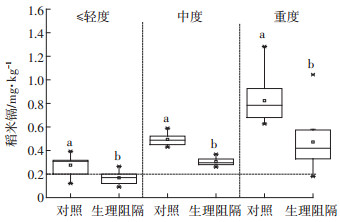
|
| 图 4 生理阻隔技术在不同污染程度田间应用降低稻米镉的效果 Figure 4 Application of physiological barrier technique to reduce cadmium of rice in paddy fields at different pollution levels |
此外,我们委托原农业部稻米及制品质量监督检验测试中心对施用生理阻隔剂后的糙米率、精米率、整精米率、垩白粒率、垩白度、直链淀粉、蛋白质及长款比等稻米品质指标进行了测定,结果表明施用生理阻隔剂对稻米品质无显著影响。
2.2 土壤钝化技术应用2013—2015年,我们在广东佛冈和仁化两地开展了为期3年的土壤钝化技术应用效果的大田试验。在水稻插秧前一周,每公顷撒施2250 kg铁基生物炭土壤调理剂。成熟期采集水稻样品,采用石墨炉原子吸收测定稻米中镉,高效液相色谱和原子荧光联用测定稻米中无机砷。总体上,土壤钝化技术应用可显著降低稻米中镉/砷的含量(图 5)。相比对照,施用铁基生物炭土壤调理剂后,稻米镉、无机砷含量均值从0.59、0.24 mg·kg-1降至0.30 mg·kg-1和0.18 mg·kg-1,降幅分别为48%和24%;按水稻的种植季节分,施用铁基生物炭土壤调理剂后早稻和晚稻的稻米镉含量与对照相比均显著降低,而稻米无机砷含量与对照比无显著性差异(图 5)。土壤中有效态的镉(乙酸和乙酸钠缓冲溶液提取)和有效态的砷(0.05 mol · L-1 NH4H2PO4提取)与对照相比显著降低。施用铁基生物炭土壤调理剂后,土壤中有效态镉、有效态砷含量均值从1.5、3.0 mg·kg-1降至1.1 mg·kg-1和2.3 mg· kg-1,降幅分别为25%和24%。这说明铁基生物炭土壤调理剂可有效降低土壤中镉和砷的移动性,从而降低镉砷在稻米中的积累。按前面提到的稻米镉/无机砷污染程度的划分标准,在广东佛冈和仁化两地开展的土壤钝化技术应用大田试验样点的稻米镉42%为轻度污染,16%为中度污染,42%为重度污染;稻米砷为轻度污染。施用铁基生物炭土壤调理剂后,轻度、中度及重度污染的稻米镉含量均值分别从0.28、0.56、0.77 mg·kg-1降至0.16、0.35、0.35 mg·kg-1,降幅分别为41%、38%及54%,与对照相比,均呈显著性差异(图 5和图 6)。
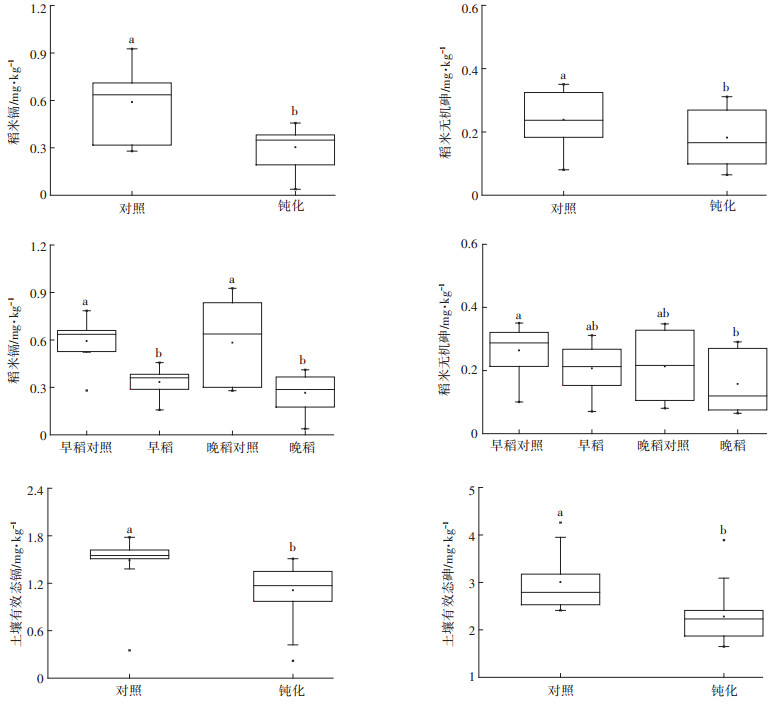
|
| 图 5 土壤钝化技术在不同季节田间应用降低稻米镉和无机砷以及土壤有效态镉和砷含量的效果 Figure 5 Application of soil passivation technique to reduce cadmium and inorganic arsenic in rice, and soil available cadmium and arsenic in paddy fields in different seasons |
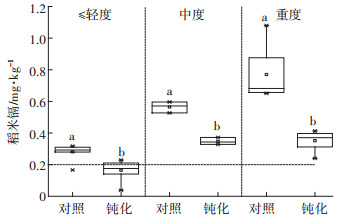
|
| 图 6 土壤钝化技术在不同污染程度田间应用降低稻米镉含量的效果 Figure 6 Application of soil passivation technology to reduce cadmium content of rice in paddy fields at different pollution levels |
此外,我们委托原农业部稻米及制品质量监督检验测试中心对施用铁基生物炭土壤调理剂后的糙米率、精米率、整精米率、垩白粒率、垩白度、直链淀粉、蛋白质及长款比等稻米品质指标进行了测定,结果表明施用铁基生物炭土壤调理剂对稻米品质无显著影响。
2.3 生理阻隔+土壤钝化技术应用2013—2015年,我们在广东省清远市佛冈县开展了为期3年的生理阻隔+土壤钝化技术应用效果的大田试验。该样点土壤pH为4.58,有机质含量15.3 g · kg-1,总镉含量2.86 mg · kg-1,总砷含量22.6 mg · kg-1。按照国家土壤环境质量标准GB 15618—1995,二级标准值总镉0.3 mg·kg-1、总砷30 mg·kg-1,广东佛冈样点的土壤为重度镉污染,土壤砷不超标。在水稻插秧前一周,每公顷撒施2250 kg铁基生物炭土壤调理剂;在水稻分蘖盛期及灌浆期以7500 mL·hm-2的用量喷施生理阻隔剂“降镉灵”。成熟期采集水稻样品,采用石墨炉原子吸收测定稻米中镉,高效液相色谱和原子荧光联用测定稻米中无机砷。总体上,生理阻隔和土壤钝化技术的单独应用及组合应用均具有较好的降镉和降砷效果(图 7)。施用生理阻隔剂后,稻米镉及无机砷含量均值从0.65、0.29 mg·kg-1降至0.39 mg·kg-1和0.18 mg·kg-1,降幅分别为40%和38%;施用铁基生物炭土壤调理剂后,稻米镉及无机砷含量均值从0.65、0.29 mg·kg-1降至0.37 mg·kg-1和0.18 mg· kg-1,降幅分别为43%和38%;同时施用生理阻隔剂和铁基生物炭土壤调理剂后,稻米镉及无机砷含量均值从0.65、0.29 mg · kg-1降至0.20 mg · kg-1和0.16 mg · kg-1,降幅分别为70%和45%。试验结果表明生理阻隔与土壤钝化的组合技术相比单一技术具有更好的降镉和降砷效果。
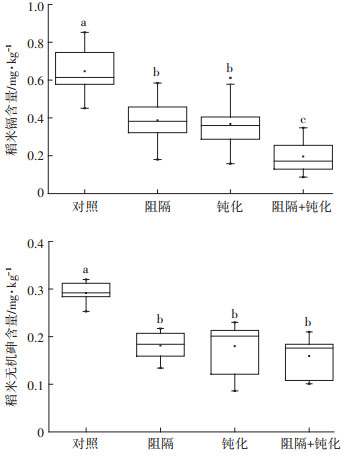
|
| 图 7 生理阻隔、土壤钝化技术及二者组合技术田间应用降低稻米镉及无机砷的长效性 Figure 7 Long-term effects of applications of physiological barriers technique,soil passivation technique and their combined techniques to reduce cadmium and inorganic arsenic of rice in paddy fields |
此外,我们对施用铁基生物炭土壤调理剂后土壤pH、有机质含量及阳离子交换容量进行了测定,结果表明施用铁基生物炭土壤调理剂可提高土壤有机质含量、阳离子交换容量,但不显著,同时可显著提高土壤pH。pH值的升高有利于铁基生物炭固定镉砷,从而降低其移动性和有效性。
3 结论我国稻田重金属污染以中轻度为主,占90%以上,稻米镉/砷超标率高的主要原因是独特的地理特点与耕作制度造成的稻田土壤中镉/砷活性较高。以农产品安全为目标,土壤铁循环钝化技术可定向调控土壤铁循环过程,降低土壤镉/砷的移动性;硅/硒营养生理阻隔技术可抑制镉/砷由水稻根系向稻米迁移,这两项技术为核心的阻控技术与农业生产相结合,实现了边生产边治理,可大幅提高中轻度污染稻田的安全利用率。
| [1] |
环境保护部, 国土资源部. 全国土壤污染状况调查公报[R/OL]. [2018-06-02]. http://www.zhb.gov.cn/gkml/hbb/qt/201404/t20140417_270670.htm. Ministry of Environmental Protection, Ministry of Land and Resources. National soil pollution investigation Bulletin[R/OL]. [2018-06-02]. http://www.zhb.gov.cn/gkml/hbb/qt/201404/t20140417_270670.htm. |
| [2] |
骆永明. 中国土壤环境污染态势及预防、控制和修复策略[J]. 环境污染与防治, 2009, 31(12): 27-31. LUO Yong-ming. Trends in soil environmental pollution and the prevention-controlling-remediation strategies in China[J]. Environmental Pollution and Control, 2009, 31(12): 27-31. DOI:10.3969/j.issn.1001-3865.2009.12.021 |
| [3] |
Zhao F J, Ma Y B, Zhu Y G, et al. Soil contamination in China:Current status and mitigation strategies[J]. Environmental Science & Technology, 2015, 49(2): 750-759. |
| [4] |
Takahashi R, Ishimaru Y, Shimo H, et al. From laboratory to field:OsNRAMP5-knockdown rice is a promising candidate for Cd phytoremediation in paddy fields[J]. Plos One, 2014, 9(6): e98816. DOI:10.1371/journal.pone.0098816 |
| [5] |
Nakanishi H, Ogawa I, Ishimaru Y, et al. Iron deficiency enhances cadmium uptake and translocation mediated by the Fe2+ transporters OsIRT1 and OsIRT2 in rice[J]. Soil Science and Plant Nutrition, 2006, 52(4): 464-469. DOI:10.1111/j.1747-0765.2006.00055.x |
| [6] |
Takahashi R, Ishimaru Y, Shimo H, et al. The OsHMA2 transporter is involved in root-to-shoot translocation of Zn and Cd in rice[J]. Plant Cell and Environment, 2012, 35(11): 1948-1957. DOI:10.1111/j.1365-3040.2012.02527.x |
| [7] |
Sasaki A, Yamaji N, Ma JF. Overexpression of OsHMA3 enhances Cd tolerance and expression of Zn transporter genes in rice[J]. Journal of Experimental Botany, 2014, 65(20): 6013-6021. DOI:10.1093/jxb/eru340 |
| [8] |
Uraguchi S, Kamiya T, Sakamoto T, et al. Low-affinity cation transporter(OsLCT1)regulates cadmium transport into rice grains[J]. Proceedings of the National Academy of Sciences of the United States of America, 2011, 108(52): 20959-20964. DOI:10.1073/pnas.1116531109 |
| [9] |
Shi S, Wang T, Chen Z, et al. OsHAC1;1 and OsHAC1;2 function as arsenate reductases and regulate arsenic accumulation[J]. Plant Physiology, 2016, 172(3): 1708-1719. DOI:10.1104/pp.16.01332 |
| [10] |
Xu J, Shi S, Wang L, et al. OsHAC4 is critical for arsenate tolerance and regulates arsenic accumulation in rice[J]. New Phytologist, 2017, 215(3): 1090-1101. DOI:10.1111/nph.2017.215.issue-3 |
| [11] |
Sun S K, Chen Y, Che J, et al. Decreasing arsenic accumulation in rice by overexpressing OsNIP1; 1 and OsNIP3; 3 through disrupting arsenite radial transport in roots[J]. New Phytologist, 2018. DOI:10.1111/nph.15190 |
| [12] |
Liao G J, Wu Q H, Feng R W, et al. Efficiency evaluation for remediating paddy soil contaminated with cadmium and arsenic using water management, variety screening and foliage dressing technologies[J]. Journal of Environmental Management, 2016, 170: 116-122. |
| [13] |
Fahad S, Hussain S, Khan F, et al. Effects of tire rubber ash and zinc sulfate on crop productivity and cadmium accumulation in five rice cultivars under field conditions[J]. Environmental Science and Pollution Research, 2015, 22(16): 12424-12434. DOI:10.1007/s11356-015-4518-3 |
| [14] |
Gu H H, Qiu H, Tian T, et al. Mitigation effects of silicon rich amendments on heavy metal accumulation in rice(Oryza sativa L.)planted on multi-metal contaminated acidic soil[J]. Chemosphere, 2011, 83(9): 1234-1240. DOI:10.1016/j.chemosphere.2011.03.014 |
| [15] |
Feng R W, Wei C Y, Tu S X, et al. A dual role of Se on Cd toxicity:Evidences from the uptake of Cd and some essential elements and the growth responses in paddy rice[J]. Biological Trace Element Research, 2013, 151(1): 113-121. DOI:10.1007/s12011-012-9532-4 |
| [16] |
McDowell R W, Catto W, Orchiston T. Can the application of rare earth elements improve yield and decrease the uptake of cadmium in ryegrass-dominated pastures?[J]. Soil Research, 2015, 53(7): 826-834. DOI:10.1071/SR15073 |
| [17] |
Shao G S, Chen M X, Wang D Y, et al. Using iron fertilizer to control Cd accumulation in rice plants:A new promising technology[J]. Science China Life Sciences, 2008, 51(3): 245-253. DOI:10.1007/s11427-008-0031-y |
| [18] |
Guo B, Liang Y, Zhu Y. Does salicylic acid regulate antioxidant defense system, cell death, cadmium uptake and partitioning to acquire cadmium tolerance in rice?[J]. Journal of Plant Physiology, 2009, 166(1): 20-31. DOI:10.1016/j.jplph.2008.01.002 |
| [19] |
Kirkham M B. Cadmium in plants on polluted soils:Effects of soil factors, hyperaccumulation, and amendments[J]. Geoderma, 2006, 137(1): 19-32. |
| [20] |
Kalembasa S, Malinowska E, Kalembasa D, et al. Impact of foliar application of tytanit on Zn, Li, Ni, Cr, Pb, and Cd contents in celery leaves[J]. Polish Journal of Environmental Studies, 2015, 24(4): 1621-1631. |
| [21] |
Srivastava R K, Pandey P, Rajpoot R, et al. Exogenous application of calcium and silica alleviates cadmium toxicity by suppressing oxidative damage in rice seedlings[J]. Protoplasma, 2015, 252(4): 959-975. DOI:10.1007/s00709-014-0731-z |
| [22] |
Liu C, Wei L, Zhang S, et al. Effects of nanoscale silica sol foliar application on arsenic uptake, distribution and oxidative damage defense in rice(Oryza sativa L.)under arsenic stress[J]. Rsc Advances, 2014, 4(100): 57227-57234. DOI:10.1039/C4RA08496A |
| [23] |
Cui J, Liu T, Li F, et al. Silica nanoparticles alleviate cadmium toxicity in rice cells:Mechanisms and size effects[J]. Environmental Pollution, 2017, 228: 363-369. DOI:10.1016/j.envpol.2017.05.014 |
| [24] |
Ma J F, Yamaji N, Mitani N, et al. Transporters of arsenite in rice and their role in arsenic accumulation in rice grain[J]. Proceedings of the National Academy of Sciences of the United States of America, 2008, 105(29): 9931-9935. DOI:10.1073/pnas.0802361105 |
| [25] |
Huang B F, Xin J L, Dai H W, et al. Effects of interaction between cadmium(Cd)and selenium(Se)on grain yield and Cd and Se accumulation in a hybrid rice(Oryza sativa)system[J]. Journal of Agricultural and Food Chemistry, 2017, 65(43): 9537-9546. DOI:10.1021/acs.jafc.7b03316 |
| [26] |
Gao M, Zhou J, Liu H, et al. Foliar spraying with silicon and selenium reduces cadmium uptake and mitigates cadmium toxicity in rice[J]. The Science of the Total Environment, 2018, 631/632: 1100-1108. DOI:10.1016/j.scitotenv.2018.03.047 |
| [27] |
蔡德龙. 中国硅肥营养研究与硅肥应用[M]. 郑州: 黄河水利出版社, 2000, 5-35. CAI De-long. Study on silicon nutrition in China and silicon application[M]. Zhengzhou: Yellow River Conservancy Press, 2000, 5-35. |
| [28] |
Yu H Y, Ding X D, Li F B, et al. The availabilities of arsenic and cadmium in rice paddy fields from a mining area:The role of soil extractable and plant silicon[J]. Environmental Pollution, 2016, 215: 258-265. DOI:10.1016/j.envpol.2016.04.008 |
| [29] |
广东省生态环境技术研究所. 一种叶面硅肥的制备方法及其使用方法: ZL201010156358. 5[P]. 2013-02-06. Institute of Eco-Environmental Science & Technology. Foliar silicon fertilizer preparation method and use method thereof: ZL201010156358. 5[P]. 2013-02-06. |
| [30] |
广东省生态环境技术研究所. 一种可以抑制水稻重金属吸收积累生产富硒稻米的硒掺杂纳米硅溶胶及其制备方法: ZL01310737996. X[P]. 2015-08-26. Institute of Eco -Environmental Science & Technology. Seleniumdoped nano-silica sol capable of inhibiting absorption and accumulation of heavy metal in rice and producing selenium-enriched rice and preparation method thereof: ZL01310737996. X[P]. 2015-08-26. |
| [31] |
广东省生态环境技术研究所. 一种可抑制水稻吸收重金属的稀土复合硅溶胶: ZL200610036994. 8[P]. 2009-03-18. Institute of Eco -Environmental Science & Technology. Rare earth composite silica sol capable of inhibiting rice from absorbing heavy metals: ZL200610036994. 8[P]. 2009-03-18. |
| [32] |
Liu C, Li F, Luo C, et al. Foliar application of two silica sols reduced cadmium accumulation in rice grains[J]. Journal of Hazardous Materials, 2009, 161(2/3): 1466-1472. |
| [33] |
徐向华, 刘传平, 唐新莲, 等. 叶面喷施硒硅复合溶胶抑制水稻砷积累效应研究[J]. 生态环境学报, 2014, 23(6): 1064-1069. XU Xiang-hua, LIU Chuan-ping, TANG Xin-lian, et al. Foliar application of selenium-silicon sol reduced arsenic accumulation in rice[J]. Ecology and Environmental Sciences, 2014, 23(6): 1064-1069. |
| [34] |
王世华, 罗群胜, 刘传平, 等. 叶面施硅对水稻籽实重金属积累的抑制效应[J]. 生态环境, 2007, 16(3): 875-878. WANG Shi-hua, LUO Qun-sheng, LIU Chuan-ping, et al. Effects of leaf application of nanometer silicon to the accumulation of heavy metals in rice grains[J]. Ecology and Environment, 2007, 16(3): 875-878. |
| [35] |
Li H, Luo N, Li Y W, et al. Cadmium in rice:Transport mechanisms, influencing factors, and minimizing measures[J]. Environmental Pollution, 2017, 224: 622-630. DOI:10.1016/j.envpol.2017.01.087 |
| [36] |
Kumarathilaka P, Seneweera S, Meharg A, et al. Arsenic speciation dynamics in paddy rice soil-water environment:Sources, physicochemical, and biological factors:A review[J]. Water Research, 2018, 140: 403-414. DOI:10.1016/j.watres.2018.04.034 |
| [37] |
Ke S, Cheng X Y, Zhang N, et al. Cadmium contamination of rice from various polluted areas of China and its potential risks to human health[J]. Environmental Monitoring and Assessment, 2015, 187(7): 408. DOI:10.1007/s10661-015-4638-8 |
| [38] |
Tlustos P, Szakova J, Korinek K, et al. The effect of liming on cadmium, lead, and zinc uptake reduction by spring wheat grown in contaminated soil[J]. Plant Soil and Environment, 2006, 52(1): 16-24. |
| [39] |
闫丰. 环境矿物材料改良土壤的研究进展[J]. 安徽农业科学, 2015, 43(21): 95-96. YAN Feng. Research progress of soil amelioration with environmental mineral materials[J]. Journal of Anhui Agricultural Science, 2015, 43(21): 95-96. DOI:10.3969/j.issn.0517-6611.2015.21.036 |
| [40] |
Usman A R A. The relative adsorption selectivities of Pb, Cu, Zn, Cd and Ni by soils developed on shale in New Valley, Egypt[J]. Geoderma, 2008, 144(1/2): 334-343. |
| [41] |
饶中秀, 朱奇宏, 黄道友, 等. 模拟酸雨条件下海泡石对污染红壤镉, 铅淋溶的影响[J]. 水土保持学报, 2013, 27(3): 23-27. RAO Zhong-xiu, ZHU Qi-hong, HUANG Dao-you, et al. Effects of sepiolite on Cd and Pb leacing in contaminated red soil under simulated acid rain[J]. Journal of Soil and Water Conservation, 2013, 27(3): 23-27. |
| [42] |
Bolan N, Mahimairaja S, Kunhikrishnan A, et al. Phosphorus-arsenic interactions in variable-charge soils in relation to arsenic mobility and bioavailability[J]. The Science of the Total Environment, 2013, 463/464(5): 1154-1162. |
| [43] |
Khan S, Reid B J, Li G, et al. Application of biochar to soil reduces cancer risk via rice consumption:A case study in Miaoqian village, Longyan, China[J]. Environment International, 2014, 68(4): 154-161. |
| [44] |
Qi Y, Szendrak D, Yuen R T W, et al. Application of sludge dewatered products to soil and its effects on the leaching behaviour of heavy metals[J]. Chemical Engineering Journal, 2011, 166(2): 586-595. DOI:10.1016/j.cej.2010.11.029 |
| [45] |
Murray H, Pinchin T A, Macfie S M. Compost application affects metal uptake in plants grown in urban garden soils and potential human health risk[J]. Journal of Soils and Sediments, 2011, 11(5): 815-829. DOI:10.1007/s11368-011-0359-y |
| [46] |
Banerjee A, Sarkar P, Banerjee S. Application of statistical design of experiments for optimization of As(Ⅴ)biosorption by immobilized bacterial biomass[J]. Ecological Engineering, 2016, 86: 13-23. DOI:10.1016/j.ecoleng.2015.10.015 |
| [47] |
Wang T, Sun H W, Mao H J, et al. The immobilization of heavy metals in soil by bioaugmentation of a UV-mutant Bacillus subtilis 38 assisted by NovoGro biostimulation and changes of soil microbial community[J]. Journal of Hazardous Materials, 2014, 278: 483-490. DOI:10.1016/j.jhazmat.2014.06.028 |
| [48] |
Li P, Wang X X, Zhang T L, et al. Distribution and accumulation of copper and cadmium in soil-rice system as affected by soil amendments[J]. Water Air and Soil Pollution, 2009, 196(1/2/3/4): 29-40. |
| [49] |
Li M, Tian X, Liu R Z, et al. Combined application of rice straw and fungus penicillium chrysogenum to remediate heavy-metal-contaminated soil[J]. Soil & Sediment Contamination, 2014, 23(3): 328-338. |
| [50] |
Borch T, Kretzschmar R, Kappler A, et al. Biogeochemical redox processes and their impact on contaminant dynamics[J]. Environmental Science & Technology, 2010, 44(1): 15-23. |
| [51] |
Yu H Y, Li F B, Liu C S, et al. Chaper five-iron redox cycling coupled to transformation and immobilization of heavy metals:Implications for paddy rice safety in the red soil of South China[M]. Amsterdam, Netherlands: Elsevier, 2016, 279-318.
|
| [52] |
Zhang J, Zhao S, Xu Y, et al. Nitrate stimulates anaerobic microbial arsenite oxidation in paddy soils[J]. Environmental Science & Technology, 2017, 51(8): 4377-4386. |
| [53] |
Zhu Y G, Yoshinaga M, Zhao F J, et al. Earth abides arsenic biotransformations[J]. Annual Review of Earth and Planetary Sciences, 2014, 42(1): 443-467. DOI:10.1146/annurev-earth-060313-054942 |
| [54] |
广东省生态环境技术研究所. 一种铁基生物炭材料、其制备工艺以及其在土壤污染治理中的应用: ZL201410538633. 8[P]. 2017-04-05. Institute of Eco -Environmental Science & Technology. Iron-based biochar material, preparation therefor and use thereof in soil pollution control: ZL201410538633. 8[P]. 2017-04-05. |
| [55] |
广东省生态环境技术研究所. 一种缓释型铁基生物炭土壤重金属钝化剂的制备及使用方法: CN201610071104. 0[P]. 2017-02-22. Institute of Eco-Environmental Science & Technology. Preparation and use of slow-release iron-based soil heavy metal passivator: CN201610071104. 0[P]. 2017-02-22. |
| [56] |
广东省生态环境技术研究所. 一种铁硅硫多元素复合生物炭土壤重金属调理剂的制备方法: CN201610115576. 1[P]. 2017-02-22. Institute of Eco -Environmental Science & Technology. Method for preparing iron-silicon-sulfur multi-element composite bio-char soil heavy metal conditioner: CN201610115576. 1[P]. 2017-02-22. |
| [57] |
广东省生态环境技术研究所. 一种铁基-腐殖质复合材料及其在土壤重金属污染治理中的应用: CN201510390750. 9[P]. 2017-02-22. Institute of Eco-Environmental Science & Technology. Iron-based humus composite material and its application in the treatment of heavy metal pollution in soil: CN201510390750. 9[P]. 2017-02-22. |
| [58] |
Qiao J T, Liu T X, Wang X Q, et al. Simultaneous alleviation of cadmium and arsenic accumulation in rice by applying zero-valent iron and biochar to contaminated paddy soils[J]. Chemosphere, 2018, 195: 260-271. DOI:10.1016/j.chemosphere.2017.12.081 |
 2018, Vol. 37
2018, Vol. 37




